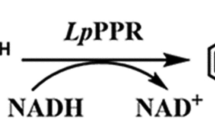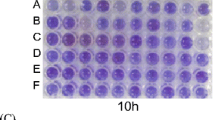Abstract
In the phenylpropanoid production process, p-coumaric acid is the most important intermediate metabolite. It is generally accepted that the activity of tyrosine ammonia-lyase (TAL), which converts l-tyrosine to p-coumaric acid, represents the rate-limiting step. Therefore, an error-prone PCR-based random mutagenesis strategy was utilized for screening variants with higher catalytic activity. After rounds of screening, three variant enzymes were obtained, exhibiting improved production rates of 41.2, 37.1, and 38.0 %, respectively. Variants associated with increased expression level (S9N), improved catalytic efficiency (A11T), and enhanced affinity between TAL and L-tyrosine (E518V) were identified as beneficial amino acid substitutions by site-directed mutagenesis. Combining all of the beneficial amino acid substitutions, a variant, MT-S9N/-A11T/-E518V, exhibiting the highest catalytic activity was obtained. The K m value of MT-S9N/-A11T/-E518V decreased by 25.4 % compare to that of wild-type, while the activity, k cat/K m, and p-coumaric-acid yield were improved by 36.5, 31.2, and 65.9 %, respectively. Furthermore, the secondary structure of the 5′-end of MT-S9N mRNA and the three-dimensional protein structure of MT-E518V were modeled. Therefore, two potential mechanisms were speculated: (1) a simplified mRNA 5′-end secondary structure promotes TAL expression and (2) anchoring the flexible loop region (Glu325–Arg336) to maintain the active-site pocket opening ensures easy access by the l-tyrosine to the active site and thus improves p-coumaric acid yields.





Similar content being viewed by others
References
Abell CW, Shen RS (1987) Phenylalanine ammonia-lyase from the yeast Rhodotorula glutinis. Methods Enzymol 142:242–253. doi:10.1016/s0076-6879(87)42033-8
Ahmed M, Goldgur Y, Hu J, Guo H-F, Cheung N-KV (2013) In silico driven redesign of a clinically relevant antibody for the treatment of GD2 positive tumors. PLoS One 8:e63359. doi:10.1371/journal.pone.0063359
Berner M, Krug D, Bihlmaier C, Vente A, Muller R, Bechthold A (2006) Genes and enzymes involved in caffeic acid biosynthesis in the actinomycete Saccharothrix espanaensis. J Bacteriol 188:2666–2673. doi:10.1128/jb.188.7.2666-2673.2006
Biasini M, Bienert S, Waterhouse A, Arnold K, Studer G, Schmidt T, Kiefer F, Cassarino TG, Bertoni M, Bordoli L, Schwede T (2014) SWISS-MODEL: modelling protein tertiary and quaternary structure using evolutionary information. Nucleic Acids Res 42:W252–W258. doi:10.1093/nar/gku340
Calabrese JC, Jordan DB, Boodhoo A, Sariaslani S, Vannelli T (2004) Crystal structure of phenylalanine ammonia lyase: multiple helix dipoles implicated in catalysis. Biochemistry 43:11403–11416. doi:10.1021/bi049053+
Cheong DE, Ko KC, Han Y, Jeon HG, Sung BH, Kim GJ, Choi JH, Song JJ (2015) Enhancing functional expression of heterologous proteins through random substitution of genetic codes in the 5′ coding region. Biotechnol Bioeng 112:822–826. doi:10.1002/bit.25478
Chica RA, Doucet N, Pelletier JN (2005) Semi-rational approaches to engineering enzyme activity: combining the benefits of directed evolution and rational design. Curr Opin Biotechnol 16:378–384. doi:10.1016/j.copbio.2005.08.004
Cobb RE, Si T, Zhao H (2012) Directed evolution: an evolving and enabling synthetic biology tool. Curr Opin Chem Biol 16:285–291. doi:10.1016/j.cbpa.2012.05.186
Cobb RE, Sun N, Zhao H (2013) Directed evolution as a powerful synthetic biology tool. Methods 60:81–90. doi:10.1016/j.ymeth.2012.03.009
Cook NC, Samman S (1996) Flavonoids-chemistry, metabolism, cardioprotective effects, and dietary sources. J Nutr Biochem 7:66–76. doi:10.1016/0955-2863(95)00168-9
Falcone Ferreyra ML, Rius SP, Casati P (2012) Flavonoids: biosynthesis, biological functions, and biotechnological applications. Front Plant Sci 3:1–15. doi:10.3389/fpls.2012.00222
Fang Z, Zhang J, Liu BH, Du GC, Chen J (2015) Insight into the substrate specificity of keratinase KerSMD from Stenotrophomonas maltophilia by site-directed mutagenesis studies in the S1 pocket. RSC Adv 5:74953–74960. doi:10.1039/C5RA12598G
Fiser A, Sali A (2003) MODELLER: generation and refinement of homology-based protein structure models. In: Carter CW, Sweet RM (eds) Macromolecular crystallography. Pt D. Elsevier Academic Press Inc, San Diego, pp. 461–491. doi:10.1016/s0076-6879(03)74020-8
Fowler ZL, Koffas MAG (2009) Biosynthesis and biotechnological production of flavanones: current state and perspectives. Appl Microbiol Biotechnol 83:799–808. doi:10.1007/s00253-009-2039-z
Hess AK, Saffert P, Liebeton K, Ignatova Z (2015) Optimization of translation profiles enhances protein expression and solubility. PLoS One 10:e0127039. doi:10.1371/journal.pone.0127039
Jendresen CB, Stahlhut SG, Li MJ, Gaspar P, Siedler S, Forster J, Maury J, Borodina I, Nielsen AT (2015) Highly active and specific tyrosine ammonia-lyases from diverse origins enable enhanced production of aromatic compounds in bacteria and Saccharomyces cerevisiae. Appl Environ Microbiol 81:4458–4476. doi:10.1128/aem.00405-15
Kaufmann KW, Lemmon GH, DeLuca SL, Sheehan JH, Meiler J (2010) Practically useful: what the ROSETTA protein modeling suite can do for you. Biochemistry 49:2987–2998. doi:10.1021/bi902153g
Kindl H (1970) The regulation of the L-tyrosine ammonia-lyase activity by phenolic compounds. Hoppe-Seyler’s Zeitschrift fur Physiologische Chemie 351:792–798. doi:10.1515/bchm2.1970.351.2.792
Kyndt JA, Meyer TE, Cusanovich MA, Van Beeumen JJ (2002) Characterization of a bacterial tyrosine ammonia lyase, a biosynthetic enzyme for the photoactive yellow protein. FEBS Lett 512:240–244. doi:10.1016/s0014-5793(02)02272-x
Lin YH, Sun XX, Yuan QP, Yan YJ (2013) Combinatorial biosynthesis of plant-specific coumarins in bacteria. Metab Eng 18:69–77. doi:10.1016/j.ymben.2013.04.004
Lineweaver H, Burk D (1934) The determination of enzyme dissociation constants. J Am Chem Soc 56:658–666. doi:10.1021/ja01318a036
Luo Y, Li B-Z, Liu D, Zhang L, Chen Y, Jia B, Zeng B-X, Zhao H, Yuan Y-J (2015) Engineered biosynthesis of natural products in heterologous hosts. Chem Soc Rev 44:5265–5290. doi:10.1039/C5CS00025D
Matsumoto K, Tanaka Y, Watanabe T, Motohashi R, Ikeda K, Tobitani K, Yao M, Tanaka I, Taguchi S (2013) Directed evolution and structural analysis of NADPH-dependent acetoacetyl coenzyme A (acetoacetyl-CoA) reductase from Ralstonia eutropha reveals two mutations responsible for enhanced kinetics. Appl Environ Microbiol 79:6134–6139. doi:10.1128/aem.01768-13
Miyahisa I, Kaneko M, Funa N, Kawasaki H, Kojima H, Ohnishi Y, Horinouchi S (2005) Efficient production of (2S)-flavanones by Escherichia coli containing an artificial biosynthetic gene cluster. Appl Microbiol Biotechnol 68:498–504. doi:10.1007/s00253-005-1916-3
Orhan IE, Nabavi SF, Daglia M, Tenore GC, Mansouri K, Nabavi SM (2015) Naringenin and atherosclerosis: a review of literature. Curr Pharm Biotechnol 16:245–251. doi:10.2174/1389201015666141202110216
Packer MS, Liu DR (2015) Methods for the directed evolution of proteins. Nat Rev Genet 16:379–394. doi:10.1038/nrg3927
Rodriguez A, Kildegaard KR, Li M, Borodina I, Nielsen J (2015) Establishment of a yeast platform strain for production of p-coumaric acid through metabolic engineering of aromatic amino acid biosynthesis. Metab Eng 31:181–188. doi:10.1016/j.ymben.2015.08.003
Santos-Martins D, Forli S, Ramos MJ, Olson AJ (2014) AutoDock4(Zn): an improved auto dock force field for small-molecule docking to zinc metalloproteins. J Chem Inf Model 54:2371–2379. doi:10.1021/ci500209e
Santos CN, Koffas M, Stephanopoulos G (2011) Optimization of a heterologous pathway for the production of flavonoids from glucose. Metab Eng 13:392–400. doi:10.1016/j.ymben.2011.02.002
Seo SW, Yang J-S, Kim I, Yang J, Min BE, Kim S, Jung GY (2013) Predictive design of mRNA translation initiation region to control prokaryotic translation efficiency. Metab Eng 15:67–74. doi:10.1016/j.ymben.2012.10.006
Takase K, Taguchi S, Doi Y (2003) Enhanced synthesis of poly(3-hydroxybutyrate) in recombinant Escherichia coli by means of error-prone PCR mutagenesis, saturation mutagenesis, and in vitro recombination of the type II polyhydroxyalkanoate synthase gene. J Biochem 133:139–145. doi:10.1093/jb/mvg015
Tian JA, Wang P, Gao S, Chu XY, Wu NF, Fan YL (2010) Enhanced thermostability of methyl parathion hydrolase from Ochrobactrum sp. M231 by rational engineering of a glycine to proline mutation. FEBS J 277:4901–4908. doi:10.1111/j.1742-4658.2010.07895.x
Vannelli T, Qi WW, Sweigard J, Gatenby AA, Sariaslani FS (2007a) Production of p-hydroxycinnamic acid from glucose in Saccharomyces cerevisiae and Escherichia coli by expression of heterologous genes from plants and fungi. Metab Eng 9:142–151. doi:10.1016/j.ymben.2006.11.001
Vannelli T, Xue Z, Breinig S, Qi WW, Sariaslani FS (2007b) Functional expression in Escherichia coli of the tyrosine-inducible tyrosine ammonia-lyase enzyme from yeast Trichosporon cutaneum for production of p-hydroxycinnamic acid. Enzym Microb Technol 41:413–422. doi:10.1016/j.enzmictec.2007.03.013
Verma R, Schwaneberg U, Roccatano D (2012) Computer-aided protein directed evolution: a review of web servers, databases and other computational tools for protein engineering. Comput Struct Biotechnol J 2:e201209008. doi:10.5936/csbj.201209008
Wang L, Gamez A, Sarkissian CN, Straub M, Patch MG, Won Han G, Striepeke S, Fitzpatrick P, Scriver CR, Stevens RC (2005) Structure-based chemical modification strategy for enzyme replacement treatment of phenylketonuria. Mol Genet Metab 86:134–140. doi:10.1016/j.ymgme.2005.05.012
Wang Q, He JW, Wu D, Wang J, Yan J, Li H (2015) Interaction of alpha-cyperone with human serum albumin: determination of the binding site by using Discovery Studio and via spectroscopic methods. J Lumin 164:81–85. doi:10.1016/j.jlumin.2015.03.025
Watts KT, Mijts BN, Lee PC, Manning AJ, Schmidt-Dannert C (2006) Discovery of a substrate selectivity switch in tyrosine ammonia-lyase, a member of the aromatic amino acid lyase family. Chem Biol 13:1317–1326. doi:10.1016/j.chembiol.2006.10.008
Wu JJ, Du GC, Zhou JW, Chen J (2013a) Metabolic engineering of Escherichia coli for (2S)-pinocembrin production from glucose by a modular metabolic strategy. Metab Eng 16:48–55. doi:10.1016/j.ymben.2012.11.009
Wu JJ, Du GC, Zhou JW, Chen J (2014a) Systems metabolic engineering of microorganisms to achieve large-scale production of flavonoid scaffolds. J Biotechnol 188:72–80. doi:10.1016/j.jbiotec.2014.08.016
Wu JJ, Liu PR, Fan YM, Bao H, Du GC, Zhou JW, Chen J (2013b) Multivariate modular metabolic engineering of Escherichia coli to produce resveratrol from L-tyrosine. J Biotechnol 167:404–411. doi:10.1016/j.jbiotec.2013.07.030
Wu JJ, Zhou TT, Du GC, Zhou JW, Chen J (2014b) Modular optimization of heterologous pathways for de novo synthesis of (2S)-naringenin in Escherichia coli. PLoS One 9:e101492. doi:10.1371/journal.pone.0101492
Xue Z, McCluskey M, Cantera K, Ben-Bassat A, Sariaslani RS, Huang L (2007a) Improved production of p-hydroxycinnamic acid from tyrosine using a novel thermostable phenylalanine/tyrosine ammonia lyase enzyme. Enzym Microb Technol 42:58–64. doi:10.1016/j.enzn-tictec.2007.07.025
Xue Z, McCluskey M, Cantera K, Sariaslani FS, Huang L (2007b) Identification, characterization and functional expression of a tyrosine ammonia-lyase and its mutants from the photosynthetic bacterium Rhodobacter sphaeroides. J Ind Microbiol Biotechnol 34:599–604. doi:10.1007/s10295-007-0229-1
Zheng L, Baumann U, Reymond JL (2004) An efficient one-step site-directed and site-saturation mutagenesis protocol. Nucleic Acids Res 32:e115. doi:10.1093/nar/gnh110
Zhou JW, Du GC, Chen J (2014) Novel fermentation processes for manufacturing plant natural products. Curr Opin Biotechnol 25:17–23. doi:10.1016/j.copbio.2013.08.009
Acknowledgments
This work was supported by the National High Technology Research and Development Program of China (863 Program, 2012AA022103), the National Natural Science Foundation of China (31370130), the Natural Science Foundation of Jiangsu Province (BK2011004), the Fundamental Research Funds for the Central Universities (JUSRP51307A), the Foundation for the Author of National Excellent Doctoral Dissertation of PR China (FANEDD, 201256), the Program for New Century Excellent Talents in University (NCET-12-0876), and the 111 Project (111-2-06).
Author information
Authors and Affiliations
Corresponding authors
Ethics declarations
This article does not contain any studies with human participants or animals performed by any of the authors.
Conflict of interest
The authors declare that they have no competing interests.
Rights and permissions
About this article
Cite this article
Zhou, S., Liu, P., Chen, J. et al. Characterization of mutants of a tyrosine ammonia-lyase from Rhodotorula glutinis . Appl Microbiol Biotechnol 100, 10443–10452 (2016). https://doi.org/10.1007/s00253-016-7672-8
Received:
Revised:
Accepted:
Published:
Issue Date:
DOI: https://doi.org/10.1007/s00253-016-7672-8




